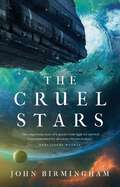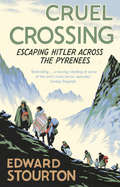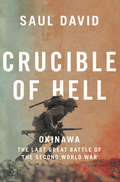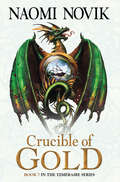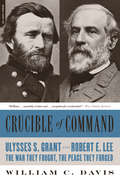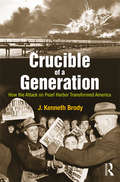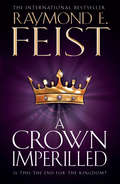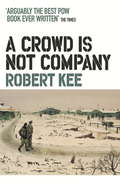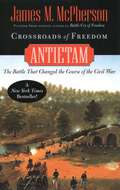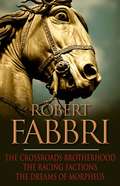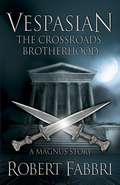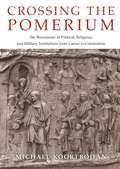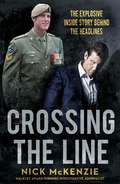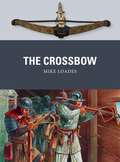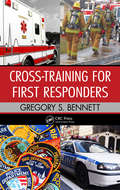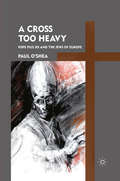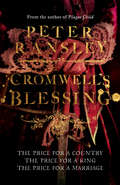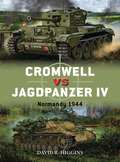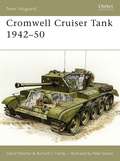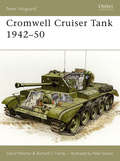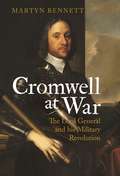- Table View
- List View
The Cruel Stars (The Cruel Stars Trilogy #1)
by John BirminghamWith a ruthless sect of humanity intent on wiping out their species, five intrepid heroes must think like their enemies in this epic SF adventure.They thought the Sturm were dead. They were wrong.Centuries after their defeat, the enemy has returned with an overwhelming attack on the fringes of human space. On the brink of annihilation, humankind's only hope is a few brave souls who survived the initial onslaught: Commander Lucinda Hardy, commander of the Royal Armadalen Navy's only surviving warship; Booker3, a soldier of Earth, sentenced to die for treason; Alessia, a young royal forced to flee when her home planet is overrun and her entire family executed; Sephina L'trel, the leader of an outlaw band. And, finally, retired Admiral Frazer McLennan, the infamous hero of the first war with the Sturm, who hopes to rout his old foes once and for all – or die trying. These five flawed, reluctant heroes must band together to prevail against a relentless enemy and near-impossible odds. For if they fail, the future itself is doomed.
Cruel Crossing: Escaping Hitler Across the Pyrenees
by Edward StourtonThe mountain paths are as treacherous as they are steep – the more so in the dark and in winter. Even for the fit the journey is a formidable challenge. Hundreds of those who climbed through the Pyrenees during the Second World War were malnourished and exhausted after weeks on the run hiding in barns and attics. Many never even reached the Spanish border. Today their bravery and endurance is commemorated each July by a trek along the Chemin de la Liberté – the toughest and most dangerous of wartime routes. From his fellow pilgrims Edward Stourton uncovers stories of midnight scrambles across rooftops and drops from speeding trains; burning Lancasters, doomed love affairs, horrific murder and astonishing heroism. The lives of the men, women and children who were drawn by the war to the Pyrenees often read as breathtakingly exciting adventure, but they were led against a background of intense fear, mounting persecution and appalling risk. Drawing on interviews with the few remaining survivors and the families of those who were there, Edward Stourton’s vivid history of this little-known aspect of the Second World War is shocking, dramatic and intensely moving.
Crucible of Hell: Okinawa - Stalingrad Of The Pacific
by Saul David‘Excellent’ Antony Beevor From award-winning historian Saul David, an action-packed and powerful new narrative of the Battle of Okinawa – the last great clash of the Second World War, and one that had profound consequences for the modern world.
Crucible of Gold (The Temeraire Series #7)
by Naomi NovikNaomi Novik’s stunning series of novels follow the global adventures of Captain William Laurence and his fighting dragon Temeraire as they are thrown together to fight for Britain during the turbulent time of the Napoleonic Wars.
Crucible of Command: Ulysses S. Grant and Robert E. Lee--The War They Fought, the Peace They Forged
by William C. DavisA dual biography and a fresh approach to the always compelling subject of these two iconic leaders-how they fashioned a distinctly American war, and a lasting peace, that fundamentally changed our nation
Crucible of a Generation: How the Attack on Pearl Harbor Transformed America
by J. Kenneth BrodyCrucible of a Generation tells the story of the fifteen days surrounding the Japanese attack on Pearl Harbor through the pages of eight leading American newspapers. Focusing on publications such as The New York Times and the Chicago Tribune, J. Kenneth Brody paints a vivid picture of U.S. political culture and society at a pivotal moment in the nation's history. Brody considers the papers in full, from headlines to "help wanted" ads, in a text richly illustrated with archival images, wartime posters, and editorial cartoons. The book provides a compelling snapshot of the United States and the role of the media at a time of dramatic tension and global change.
Crucible of a Generation: How the Attack on Pearl Harbor Transformed America
by J. Kenneth BrodyCrucible of a Generation tells the story of the fifteen days surrounding the Japanese attack on Pearl Harbor through the pages of eight leading American newspapers. Focusing on publications such as The New York Times and the Chicago Tribune, J. Kenneth Brody paints a vivid picture of U.S. political culture and society at a pivotal moment in the nation's history. Brody considers the papers in full, from headlines to "help wanted" ads, in a text richly illustrated with archival images, wartime posters, and editorial cartoons. The book provides a compelling snapshot of the United States and the role of the media at a time of dramatic tension and global change.
Crucial Intercept
by Don PendletonA series of high-profile shootings in Virginia exposes a deadly scavenger hunt with numerous factions competing for the prize. An ex-CIA cryptologist who created an unbreakable code has unwittingly been sold out to the terrorist group who can get to him first.
A Crown Imperilled: Book Two Of The Chaoswar Saga (The Chaoswar Saga #2)
by Raymond E. FeistThe penultimate volume of the mighty Riftwar Cycle
A Crowd Is Not Company (Phoenix Press Ser.)
by Robert KeeJournalist and broadcaster Robert Kee was an RAF bomber pilot in the Second World War. When his plane was shot down over Nazi-occupied Holland, he was captured and spent three years and three months in a German POW camp. From the beginning he was intent on escape. After several false starts, he finally made it. First published in 1947 as a novel, but now revealed to be an autobiography, A Crowd Is Not Company recounts Kee's experiences as a prisoner of war and describes in compelling detail his desperate journey across Poland - a journey that meant running the gauntlet of Nazism.
Crossroads of Freedom: Antietam (Pivotal Moments in American History)
by James M. McPhersonThe Battle of Antietam, fought on September 17, 1862, was the bloodiest single day in American history, with more than 6,000 soldiers killed--four times the number lost on D-Day, and twice the number killed in the September 11th terrorist attacks. In Crossroads of Freedom, America's most eminent Civil War historian, James M. McPherson, paints a masterful account of this pivotal battle, the events that led up to it, and its aftermath. As McPherson shows, by September 1862 the survival of the United States was in doubt. The Union had suffered a string of defeats, and Robert E. Lee's army was in Maryland, poised to threaten Washington. The British government was openly talking of recognizing the Confederacy and brokering a peace between North and South. Northern armies and voters were demoralized. And Lincoln had shelved his proposed edict of emancipation months before, waiting for a victory that had not come--that some thought would never come. Both Confederate and Union troops knew the war was at a crossroads, that they were marching toward a decisive battle. It came along the ridges and in the woods and cornfields between Antietam Creek and the Potomac River. Valor, misjudgment, and astonishing coincidence all played a role in the outcome. McPherson vividly describes a day of savage fighting in locales that became forever famous--The Cornfield, the Dunkard Church, the West Woods, and Bloody Lane. Lee's battered army escaped to fight another day, but Antietam was a critical victory for the Union. It restored morale in the North and kept Lincoln's party in control of Congress. It crushed Confederate hopes of British intervention. And it freed Lincoln to deliver the Emancipation Proclamation, which instantly changed the character of the war. McPherson brilliantly weaves these strands of diplomatic, political, and military history into a compact, swift-moving narrative that shows why America's bloodiest day is, indeed, a turning point in our history.
The Crossroads Brotherhood Trilogy: From the bestselling author of the VESPASIAN series (The\crossroads Brotherhood Ser. #4)
by Robert FabbriStarring characters from the bestselling Vespasian series, The Crossroads Brotherhood, The Racing Factions and The Dreams of Morpheus delve into Rome's criminal underworld. In each of these exclusive e-novellas, Marcus Salvius Magnus, leader of the Crossroads Brotherhood, must overcome his own problems whilst battling his way through Rome's savage and corrupt political arena.THREE VESPASIAN NOVELLAS______________________________________________Don't miss Robert Fabbri's epic new series Alexander's Legacy
The Crossroads Brotherhood: A Crossroads Brotherhood Novella from the bestselling author of the VESPASIAN series (A Crossroads Brotherhood Novella #1)
by Robert FabbriRome, AD 25: Marcus Salvius Magnus, Patron of the Crossroads Brotherhood, has a problem. In fact, he has two. One of the brothels under his protection has been raided by a rival Brotherhood, and valuable merchandise has been stolen. He can't lose face and let the attack go unpunished, but how can he retaliate without igniting a gang war? At the other end of the social spectrum, Lady Antonia - the emperor's sister-in-law - has let Senator Gaius Vespasius Pollo know that she has a score that only blood will settle, and Magnus owes the Senator a favour. Now, a simple assassination wouldn't be a problem for a man like Magnus, but the instruction is that this death has to be a little more... inventive... than the usual knife-in-the-back-in-a-dark-alley. Perhaps the Patronus of the Crossroads Brotherhood can kill two birds with one stone?A VESPASIAN NOVELLA______________________________________________Don't miss Robert Fabbri's epic new series Alexander's Legacy
Crossing the Pomerium: The Boundaries of Political, Religious, and Military Institutions from Caesar to Constantine
by Michael KoortbojianA multifaceted exploration of the interplay between civic and military life in ancient RomeThe ancient Romans famously distinguished between civic life in Rome and military matters outside the city—a division marked by the pomerium, an abstract religious and legal boundary that was central to the myth of the city's foundation. In this book, Michael Koortbojian explores, by means of images and texts, how the Romans used social practices and public monuments to assert their capital's distinction from its growing empire, to delimit the proper realms of religion and law from those of war and conquest, and to establish and disseminate so many fundamental Roman institutions across three centuries of imperial rule.Crossing the Pomerium probes such topics as the appearance in the city of Romans in armor, whether in representation or in life, the role of religious rites on the battlefield, and the military image of Constantine on the arch built in his name. Throughout, the book reveals how, in these instances and others, the ancient ideology of crossing the pomerium reflects the efforts of Romans not only to live up to the ideals they had inherited, but also to reconceive their past and to validate contemporary practices during a time when Rome enjoyed growing dominance in the Mediterranean world.A masterly reassessment of the evolution of ancient Rome and its customs, Crossing the Pomerium explores a problem faced by generations of Romans—how to leave and return to hallowed city ground in the course of building an empire.
Crossing the Pomerium: The Boundaries of Political, Religious, and Military Institutions from Caesar to Constantine
by Michael KoortbojianA multifaceted exploration of the interplay between civic and military life in ancient RomeThe ancient Romans famously distinguished between civic life in Rome and military matters outside the city—a division marked by the pomerium, an abstract religious and legal boundary that was central to the myth of the city's foundation. In this book, Michael Koortbojian explores, by means of images and texts, how the Romans used social practices and public monuments to assert their capital's distinction from its growing empire, to delimit the proper realms of religion and law from those of war and conquest, and to establish and disseminate so many fundamental Roman institutions across three centuries of imperial rule.Crossing the Pomerium probes such topics as the appearance in the city of Romans in armor, whether in representation or in life, the role of religious rites on the battlefield, and the military image of Constantine on the arch built in his name. Throughout, the book reveals how, in these instances and others, the ancient ideology of crossing the pomerium reflects the efforts of Romans not only to live up to the ideals they had inherited, but also to reconceive their past and to validate contemporary practices during a time when Rome enjoyed growing dominance in the Mediterranean world.A masterly reassessment of the evolution of ancient Rome and its customs, Crossing the Pomerium explores a problem faced by generations of Romans—how to leave and return to hallowed city ground in the course of building an empire.
Crossing the Line
by Nick McKenzie'There is no doubt the truth would have been concealed and our concerns buried without Nick McKenzie's relentless pursuit of justice.' SAS Afghanistan veteranWar is brutal. But there are lines that should never be crossed. In mid-2017, whispers of executions, and cover-ups within Australia's most secretive and elite military unit, the SAS, reached Walkley Award-winning journalist Nick McKenzie. He and Chris Masters began an investigation that would not only reveal shocking truths about Ben Roberts-Smith VC but plunge the reporters into the defamation trial of the century.For five years, McKenzie led the investigation, waging an epic battle for the truth to be acknowledged. His fight to reveal the real face of Australia's most famous and revered SAS soldier and examine evidence of bullying, intimidation, war crimes and murder would take him across Australia and to Afghanistan.As he unearthed the secrets Ben Roberts-Smith had thought he'd long ago buried, McKenzie had to deal with death threats, powerful forces intent on destroying his career and attempts to silence brave SAS soldiers, who had witnessed their famous comrade commit unspeakable acts. McKenzie would break the stories that proved the man idolised by the public, politicians, the media and leading business leaders was a myth. His efforts would help deliver justice to Roberts-Smith's victims and their families.Explosive and meticulously researched, Crossing the Line shares the powerful untold story of how a small group of brave soldiers and two determined reporters overcame a plot to suppress one of the greatest military scandals in Australian history.
The Crossbow (Weapon #61)
by Peter Dennis Mike LoadesTechnologically sophisticated and powerful, the crossbow has long enjoyed a popular reputation for villainous superiority because it could be used with little training as a weapon of assassination. The study of bow designs, trigger mechanisms and spanning devices reveals a tale of considerable mechanical ingenuity; advances that produced a battlefield weapon requiring comparatively little training to use. It was an extremely useful weapon, and especially effective in siege warfare for both attack and defence.Known to the Ancient Greeks and the Chinese as early as the 5th century BC, the crossbow developed both in Western Europe and in the Far East. Advances in trigger mechanisms, spanning and bow design allowed the development of ever more powerful bows. In this study acknowledged weaponry expert Mike Loades traces the origins, development, combat record and lasting legacy of the crossbow, the formidable projectile weapon that played a key role in a host of battles and sieges across Europe and Asia.
Cross-Training for First Responders
by Gregory BennettThe tragedy that occurred in the United States on September 11, 2001 brought enhanced emergency preparedness among first responders to the forefront of public awareness. Since those events � and despite significant progress made in many of the areas previously deemed deficient � some response areas are still woefully inadequate. Cross-Training for
A Cross Too Heavy: Pope Pius XII and the Jews of Europe
by P. O'SheaThe papacy of Pius XII (1939-1958) has been a source of near-constant criticism and debate since his death, particularly because of his alleged silence during the Holocaust. Paul O'Shea examines his little-studied pre-papal life to demonstrate that Pius was neither an anti-Semitic villain nor a 'lamb without stain.'
Cromwell’s Blessing
by Peter RansleyThe price for a country. The price for a King. The price for a marriage. The dramatic story of Tom Neave continues…
Cromwell vs Jagdpanzer IV: Normandy 1944 (Duel #86)
by Johnny Shumate David R. Higgins Alan GillilandBy 1944, the evolution of armoured doctrine had produced very different outcomes in Britain and Germany. Offering a good balance of speed, protection and firepower, the British Cromwell tank was much faster than its German opponent, but the Jagdpanzer IV tank destroyer had a high-velocity main gun and a lower profile that made it formidable on the defensive, especially in ambush situations. The two types would fight in a series of bloody encounters, from the initial days of the struggle for Normandy through to its climax as the Allies sought to trap their opponents in the Falaise Pocket. Using archive photographs, specially commissioned artwork and battle reports, this fascinating study expertly assesses the realities of tactical armoured combat during the desperate battles after D-Day.
Cromwell vs Jagdpanzer IV: Normandy 1944 (Duel #86)
by Johnny Shumate David R. Higgins Alan GillilandBy 1944, the evolution of armoured doctrine had produced very different outcomes in Britain and Germany. Offering a good balance of speed, protection and firepower, the British Cromwell tank was much faster than its German opponent, but the Jagdpanzer IV tank destroyer had a high-velocity main gun and a lower profile that made it formidable on the defensive, especially in ambush situations. The two types would fight in a series of bloody encounters, from the initial days of the struggle for Normandy through to its climax as the Allies sought to trap their opponents in the Falaise Pocket. Using archive photographs, specially commissioned artwork and battle reports, this fascinating study expertly assesses the realities of tactical armoured combat during the desperate battles after D-Day.
Cromwell Cruiser Tank 1942–50 (New Vanguard)
by Peter Sarson David Fletcher Richard C HarleyFor most of World War II, British tank development remained faithful to the design philosophy inaugurated during World War I. Experiences in North Africa highlighted flaws in this basic design, however, and the General Staff identified the need for a new heavy cruiser that could combine speed and manoeuvrability with increased armour and armament. The Cromwell Cruiser tank was designed as a result and soon proved itself one of the fastest and most successful tanks deployed by the Allies during World War II. This book details the design and development of the Cromwell and its many variants, from its introduction at D-Day, through its many successes in the final year of World War II and beyond.
Cromwell Cruiser Tank 1942–50 (New Vanguard #104)
by Peter Sarson David Fletcher Richard C HarleyFor most of World War II, British tank development remained faithful to the design philosophy inaugurated during World War I. Experiences in North Africa highlighted flaws in this basic design, however, and the General Staff identified the need for a new heavy cruiser that could combine speed and manoeuvrability with increased armour and armament. The Cromwell Cruiser tank was designed as a result and soon proved itself one of the fastest and most successful tanks deployed by the Allies during World War II. This book details the design and development of the Cromwell and its many variants, from its introduction at D-Day, through its many successes in the final year of World War II and beyond.
Cromwell at War: The Lord General and his Military Revolution
by Martyn BennettOliver Cromwell was arguably the most significant political figure in the early modern history of the British Isles. Yet he was also a military leader, with significant battlefield victories to his credit. Martyn Bennett here provides the first military biography of Cromwell in the context of the seventeenth century Military Revolution. After commanding a small troop in 1643 and, without prior military experience, Cromwell rose to lead the cavalry regiments of the Eastern Association Army and the New Model Army to final victory at Worcester in 1651 and sealed the victory of the Parliamentary forces in Ireland and Scotland, becoming Lord General in 1650. Martyn Bennett analyses Cromwell's military talents and generalship, in addition to his well-attested powerful and even brutal discipline and religious fervour. He examines the controversial Irish campaigns as well as modern accusations of genocide. In providing new perspectives on Cromwell's military career, Bennett adds to our understanding of England's only non-royal head of state.
